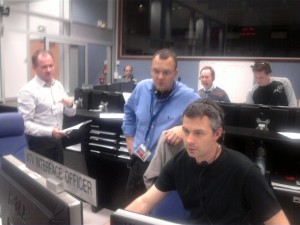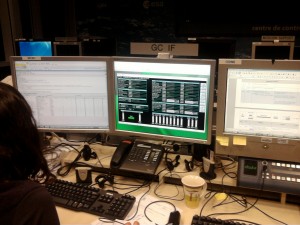For the first time this evening, live telemetry – data signals – were received from ATV via the newly developed back-up proximity link system (see our earlier post announcing the test).

ATV Mission Director Kris Capelle (blue shirt) monitors the test with Flight Director Cedric Delmas (seated)
The signals were transmitted from ATV-2, which is mounted on top of Ariane 5 in the assembly building near the launch pad in Kourou, over the air to ESA’s 15m Kourou tracking station using the vessel’s proximity link radio. Kourou station (‘Diane station’) is part of the Agency’s ESTRACK network and, as the name implies, is also located at Kourou – just a few kilometres line-of-sight from ATV.
The signals were then sent from Kourou station to the ESTRACK Control Centre at the European Space Operations Centre in Darmstadt, Germany, and from there relayed over to ATV-CC in Toulouse.
ESA’s Fabio Sintoni, lead engineer working on the back-up proximity link system, just sent in these photos (thanks, Fabio!).
The successful test ensures that ATV’s proximity link can be used as a (third) back-up communication channel, with ATV transmitting directly from space to ESA tracking stations on Earth. ATV normally communicates via NASA’s TDRSS data relay satellite system or via ESA’s own Artemis data relay satellite.
The video shot by ESA’s Human Spaceflight editor Jari Makinen is now live in YouTube – and below (thanks, Jari!).


 Automated Transfer Vehicle page
Automated Transfer Vehicle page ATV blog archive
ATV blog archive
Discussion: 2 comments
Great support from everybody!! Via the voice loops we didn´t have the chance to see our colleagues at CNES. Nice video!! I saw few known faces 🙂 and now looking forward to the 15th 😉
As technical lead of this project, I must say that the most rewarding aspect of succeeding is not the fact that this was never done before, but to have seen the smiling faces of my colleagues!
The ‘Proximity Link’ backup was first proposed in 2008, but, due to time and resource constraints, it could be assessed only in time for ATV Johannes Kepler. Indeed, the idea was good! At the beginning of 2009, when I was asked by the ATV Project to “re-open the case” for the next ATV, I had first to convince myself on the basis of a technical analysis that it was not just a good idea, but also technically feasible and – like all [technology] projects – would be worth the money and be ready in time!
Well – having confirmed these points, and thanks to all people who joined the project team and shared their experience and enthusiasm, developing the system was like putting together some special Lego building blocks (Lego were one of my favourite toys during childhood). Everything was almost in place: the challenge was mounting them all together, and the reward was to see smiling people around me.